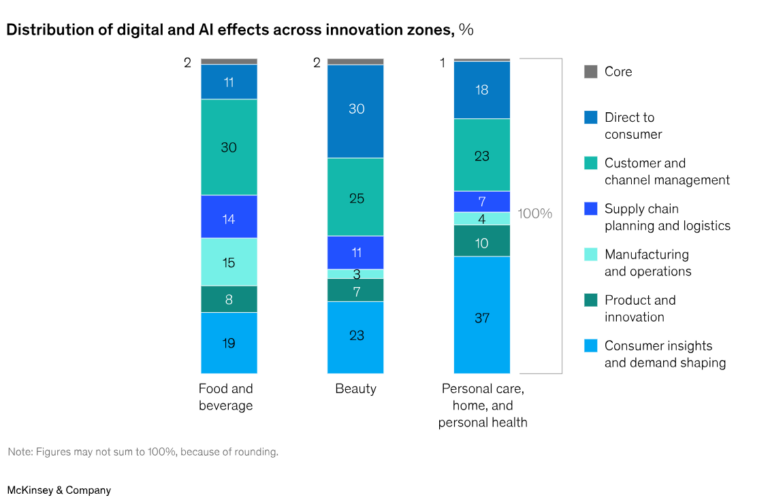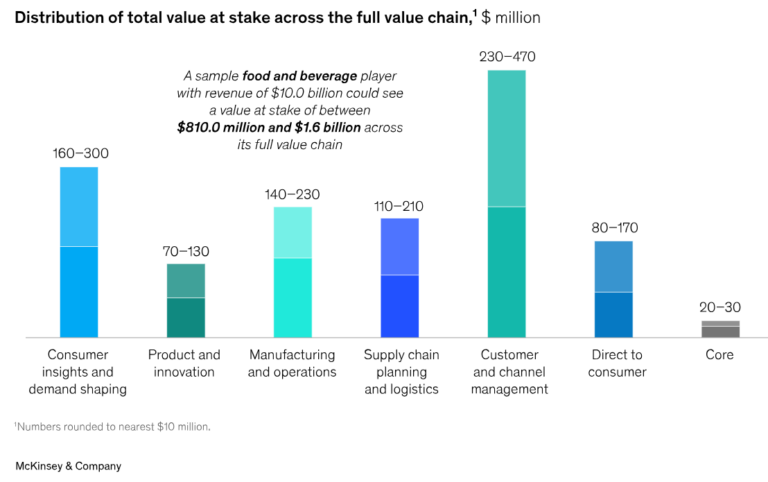The Real Value of a Digital and AI Transformation in CPG
The narrative surrounding generative AI (gen AI), a moon shot, once-in-a-generation innovation, is that it could utterly reinvent how businesses—consumer-packaged-goods (CPG) companies among them—are run. CPG leaders are heeding the call. In a 2024 survey of CPG leaders,1 71 percent said they adopted AI in at least one business function of their organizations (up from 42 percent in 2023), while 56 percent said they were regularly using gen AI.
However, no CPG player has truly scaled its gen AI and traditional AI capabilities. So far, CPG leaders have reported adopting gen AI at a lower rate than other industries, such as advanced industries or technology, media, and telecommunications. This may be because leaders lack answers to questions such as, “How much value will AI eventually create in CPG?” and “Where in the value chain will the value be concentrated?”
We sought fact-based answers to these questions to help CPGs figure out where to focus and how fast to move.
We found that the highest-impact investment areas vary, depending on which subsector a CPG company plays in. Our findings can help CPG leaders determine their next moves in digital and AI (outlined in our article, “What it takes to rewire a CPG company to outcompete in digital and AI”).
Quantifying the effects across the CPG value chain
After conducting a rigorous company-specific quantitative analysis of more than 140 use cases and dozens of expert interviews (see sidebar, “About the research”), we have aggregated subsector-specific estimates to determine the value that CPG companies in the three major subsectors—food and beverage, personal care and home, and beauty—can generate by committing to digital and AI investments. (In this article, “digital and AI” refers to all use cases across digital, analytics, machine learning, traditional AI, and generative AI.) We quantified the value at stake in the main parts of the CPG value chain: the core functions (including back-office support functions) and six innovation zones, as shown in Exhibit 1. Together, the core functions and the innovation zones make up a CPG company’s seven major value streams.
Enterprise and support functions, such as human resources and finance departments, will surely benefit from the use of new digital tools, and partnerships and an ecosystem strategy can enable a CPG company to thrive (they can do this in collaboration with suppliers and channel partners). But the most significant value an organization will get from a digital and AI transformation happens in the six innovation zones.

Consider the product and innovation domain, where digital and AI tools can be leveraged throughout the entire cycle: social listening powered by natural-language processing, feedback mining, and consumer-backed predictive trend sourcing can lead to new product ideas or product improvements. AI can suggest new formulations for existing products, while advanced analytics can improve packaging design. Automated, collaborative testing and experimentation can make launching a new product easier.
This domain can further benefit from generative AI (gen AI) applications. We’ve already seen this technology have an effect on CPG companies. One beverage player, for instance, used gen AI to create prompts, images, and concepts that informed product development, reducing the time to introduce a new product to market by 60 percent. After conducting a gen-AI-powered sentiment analysis based on customers’ online posts, the team generated insights to understand how customers felt about the products that gen AI helped to develop. The company’s gen AI efforts have yielded a portfolio of new products and experiences that have helped fuel growth and expand market share.
Our latest research estimates that gen AI use cases could increase the economic impact of traditional AI by 15 to 40 percent, unlocking an additional $160 billion to $270 billion annually in profit (measured by EBITDA) for CPG companies globally. That said, although gen AI is dazzling the business world and setting the media ablaze, it’s merely the proverbial cherry on top: traditional AI’s potential impact is 2.5 to 7.0 times higher than that of gen AI. This means that companies should invest in a broad spectrum of AI capabilities and platforms to realize a digital transformation’s full potential.
While the potential effects of digital and AI will vary across CPG sectors, our analysis shows that the greatest value for most sectors is concentrated most heavily in two value streams: consumer insights and demand shaping and customer and channel management (Exhibit 2).

One notable exception is the beauty industry, where the direct-to-consumer value stream takes center stage. This reflects beauty companies’ ability to take advantage of their unique relationship with consumers and cater directly to their shoppers. Digitally enabled beauty companies can leverage new technologies to enhance the consumer experience, the e-commerce process, and fulfillment management.
In the six domains, cooperation with ecosystem partners unlocks the next level of value. Much of this comes down to a data exchange with ecosystem partners, such as retailers, manufacturers, logistics providers, and media partners. CPG companies have historically been unable to collect and activate personalized, first-party data at scale. This lack of data means they must decide either to rely on their partners for third-party data or to invest in ways to acquire “zero party” and first-party data. This data is key to being able to deliver the right message to the right customer at the right moment. CPG companies must also invest in the right technology to enable the data exchange among ecosystem partners. Adopting the cloud here can help.
The value at stake in three CPG subsectors
Consider the effect that digital transformations could have on the following types of CPG companies. The three illustrative examples below offer case studies on how to realize these gains.
Food and beverage companies can seize the customer and channel management opportunity
For a food and beverage company with $10.0 billion in revenue, the value at stake from implementing digital and AI successfully and comprehensively across the full value chain is between $810.0 million and $1.6 billion, driven by both top-line growth and productivity gains (Exhibit 3). This translates into an EBITDA margin increase of approximately seven to 13 percentage points for food and beverage players.

The largest potential impact—valued between approximately $230 million and $470 million—lies in customer and channel management, as food and beverage companies continually seek to optimize their presence across online and offline retailers.
Specifically, retail trade promotions, which can account for as much as 20 percent of revenue for a food and beverage company, are particularly ripe for digital and analytics optimization. Retailers typically have data about past promotion performance but may not have the tools to synthesize the data to build a clear picture of how to target promotions. Digital and analytics tools can leverage historical promotion and stock data to inform the extent and timing of future promotions. Because updating and synthesizing data without advanced analytics and AI tools can be expensive, using these tools can help food and beverage companies reduce costs while simultaneously improving performance.
Conclusion
CPG companies have an opportunity to take advantage of a five- to 15-percentage-point impact on EBITDA margins, which our analysis indicates is on the table from digital transformations across their value chains. As alluring as those wins may be, they won’t come without a long-term, large-scale, and iterative effort.
Consumer goods players will need to home in on the six innovation zones and prioritize the plays that best serve their business. Keep in mind: the full impact of this transformation, one that will create competitive distance from challengers, will not come with a piecemeal approach.
“Rewired” companies, as we call them, take an all-hands-on-deck approach across commercial, operational, and support domains. This includes creating a digital road map, empowering talent, rethinking the CPG operating model, developing and acquiring new technological tools, and building out the data products necessary to implement and scale their digital transformation.
Although in its earliest days, the next great technological revolution is here. The fruits of the revolution may take a while to ripen, but putting their potential to work now will create more long-term value than could ever be contained within a single earnings statement.